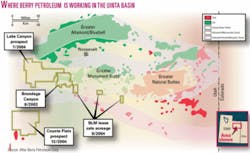Northeastern Utah’s Uinta basin is under intense exploration and development for oil and gas in multiple formations by numerous operators.
The area is showing promise for Berry Petroleum Co., Bakersfield, an experienced California heavy oil producer that is expanding into natural gas, coalbed methane, and light oil. Berry has extended operations into the Piceance, Denver-Julesburg, Williston, Uinta, and other US onshore basins.
Initial performance of two discovery wells the company reported in mid-January 2006 on its Lake Canyon prospect on the west side of the Uinta basin “suggests that expected reserves per well are on par with the Brundage Canyon field that is currently being developed on 40-acre spacing,” Berry said.
Berry had three drilling rigs under contract in mid-January to work on its Lake Canyon, Brundage Canyon, and Coyote Flats acreage.
The company said in early 2005 that gas from the Lake Canyon and Coyote Flats joint ventures could, if successful, “present Berry with development opportunities that will produce much more gas than the 37 MMcfd” it consumes for steam generation in California.
Lake Canyon-Brundage Canyon
The two discoveries lie on Berry’s Lake Canyon prospect more than three miles west of the nearest wells in Brundage Canyon oil and gas field.
The Nielsen Marsing and Taylor Herrick wells tested at 98 boe/d and 163 boe/d, respectively. The wells are on the central part of a 50 sq mile 3D seismic survey where data are under evaluation.
Initial production from the Nielsen Marsing well is limited to two of five completion intervals. Completion is to be optimized when gas facilities are completed. Production from the Taylor Herrick well is not at capacity because more facilities are being installed.
Berry et al. plan to drill four more shallow wells at Lake Canyon in the next few months.
The companies are also evaluating an exploratory well to Cretaceous Mesaverde at TD 14,200 ft that was spudded in October 2005. Berry plans to participate in another Mesaverde test in 2006.
The Lake Canyon prospect covers 171,000 gross acres. Working interest in the shallow formations are Berry 56.25%, Ute Energy LLC 25%, and Bill Barrett Corp., Denver, 18.75%. Ute Energy is a company affiliated with the Ute Indian Tribe.
Brundage Canyon field, Berry’s first light oil acquisition, produces 42° gravity waxy crude from the Eocene Green River formation at 6,000 ft or less through 164 wells.
Berry’s 2006 budget calls for spending $58 million for Green River development at the field, including a pilot project on 20-acre spacing.
The field averaged an estimated 5,000 boe/d in 2005 compared with 1,200 boe/d when Berry acquired it in August 2003. The field’s proved reserves are 13.2 million boe, and several hundred locations remain to be drilled.
Ute Energy said it has established production in four project areas on tribal lands in the eight months since its formation. The company plans to participate in more than 50 new wells in 2006.
Meanwhile, Berry picked up several blocks southeast of Brundage Canyon at a US Bureau of Land Management lease sale in September 2004.
Coyote Flats, Big Wash
Berry is also chasing gas in the Cretaceous Ferron sandstone and CBM in Emery coal beds on its Coyote Flats acreage 35 miles southwest of Brundage Canyon and shallow oil and deeper gas potential on its Big Wash Unit near Brundage Canyon field. Berry is earning an interest in the Coyote Flats acreage, which was the subject of a late 2004 development agreement with Petro-Canada Resources (USA) Inc.
The Ferron discovery well, Scofield-Thorpe 22-41, flowed gas at a peak rate of 1.1 MMcfd on a 30-day test in December 2003. Berry is drilling an offset, Scofield-Thorpe 23-31, to TD 6,800 ft.
The company plans to drill five wells to test the Emery coal beds in the first half of 2006. Range of TDs is 3,500-4,500 ft.
A 13-mile pipeline has been proposed that would serve the Ferron and Emery projects. It would run south to connect with the Questar Pipeline.


